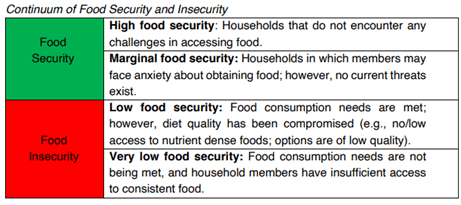By Barbara O’Neill, Ph.D., CFP®, AFC®
Martie Gillen, Ph.D., MBA, AFC®, CFLE
The statistics are startling! An academic synthesis of empirical studies of food insecurity in military families from the 2010s decade found about 15% of military families- 1 in 7- experienced some level of food insecurity at some point. A more recent study authorized by the Department of Defense placed the percentage at 24% of active duty service members or almost 1 in 4. Junior enlisted members were at the highest risk for food insecurity.
What is food insecurity? Let’s start with its polar opposite: food security, which the U.S. Department of Agriculture (USDA) defines as “access by all family members at all times to enough food for an active, healthy life.” This definition implies that food is safe to eat and nutritionally adequate. According to USDA, there are four levels of food security: two for food security and two for food insecurity. See the table below.

Source: Clearinghouse for Military Family Readiness, Penn State University
With a low level of food insecurity, food quality (i.e., nutritional value) and variety are reduced without disrupting food quantity. With very low food insecurity, both consistent access to food and eating patterns are disrupted. Food insecurity has consistently been found to be associated with poor health outcomes in both children and adults, including increased risk for chronic illness.
With so many military families experiencing food insecurity, Personal Financial Managers may find themselves making resource referrals to help military families stretch their food dollars. Below are eight resources that can assist food-insecure military families:
- Commissary Your Everyday Savings (YES!) program with year-round savings on popular items
- Department of Defense Family Subsistence Supplemental Allowance (FSSA)
- Emergency food assistance through community- or installation-based food banks and food pantries
- USDA Expanded Food and Nutrition Education Program (EFNEP), a nutrition education program
- USDA school meal programs (school breakfast, school lunch, and summer food service programs)
- USDA SNAP-Ed program, an education program focused on helping people stretch their food dollars
- USDA Special Supplemental Nutrition Program for Women, Infants, and Children (WIC)
- USDA Supplemental Nutrition Assistance Program (SNAP), formerly known as food stamps
Military service providers can learn additional information to help food-insecure military families by viewing the OneOp Helping Clients Inflation-Proof Their Budget webinar.
Photo by Alex Green on Pexels















